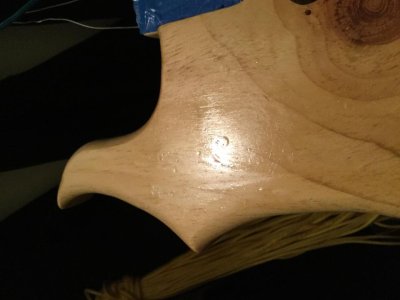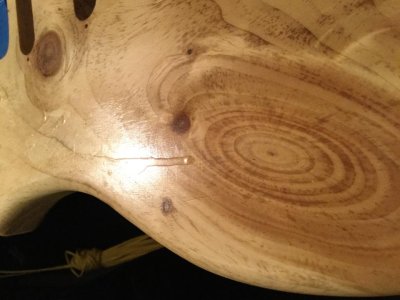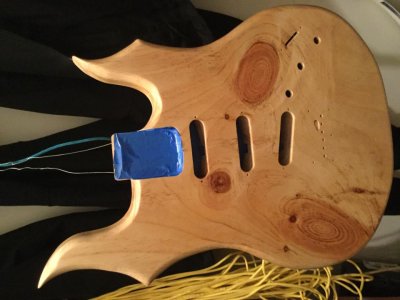The Posh Mushroom
New member
Hello everybody, I just wanted to ask for some help and advice. Maybe some of you have seen my project, I've posted once or twice about it. Anyways, it's a sort-of partscaster, in that I bought the neck, but made the body. Speaking of that body, it is roughly inspired by Jerry Garcia's Tiger and/or Rosebud guitars, made out of a StewMac Knotty Pine Blank, but with strat wiring, and a side jack, Tele-style. (always hated the front jacks for some reason, not really sure of its the look or the feel, or them constantly tugging at you just a bit when walking away from the amp.)
Anyways, I've been finishing it recently, first with a thin coat of sanding sealer, and then lacquer, all from rattle cans (also from StewMac). It has started to drip horrible on the front and a little on the sides. First off, how can I get rid of these specific drips? I would think sanding, but do I need to sand to bar wood, or just until it's flush? Also, approximately what grit should I be using to do this. Secondly, how can I not get drips in the future. Thirdly, how many coats should I do, if I then want to sand/buff it to a mirror finish? (or as close as I can get to it :18 . Ill attach pictures down below....
. Ill attach pictures down below....
Also, for the future, is there any good way to protect this, case wise? I don't know of any cases that would give enough support that I would not have to worry about the horns, as they get rather thin... and any custom case would be way out of my budget. I thought about maybe a nicely padded gig bag, any suggestions? If anyone has a good solution, please relay that to me. BTW it's about 13 inches wide at the widest point, (the body curves), and 17 inches from the large horn down, and it will have a normal Stratocaster neck with the accompanying scale length.
Well thanks for reading all my blabbering and (probably) stupid questions
 . Also, as you can probably tell, this is my first guitar. (do with that info as you will)
. Also, as you can probably tell, this is my first guitar. (do with that info as you will)



Anyways, I've been finishing it recently, first with a thin coat of sanding sealer, and then lacquer, all from rattle cans (also from StewMac). It has started to drip horrible on the front and a little on the sides. First off, how can I get rid of these specific drips? I would think sanding, but do I need to sand to bar wood, or just until it's flush? Also, approximately what grit should I be using to do this. Secondly, how can I not get drips in the future. Thirdly, how many coats should I do, if I then want to sand/buff it to a mirror finish? (or as close as I can get to it :18
Also, for the future, is there any good way to protect this, case wise? I don't know of any cases that would give enough support that I would not have to worry about the horns, as they get rather thin... and any custom case would be way out of my budget. I thought about maybe a nicely padded gig bag, any suggestions? If anyone has a good solution, please relay that to me. BTW it's about 13 inches wide at the widest point, (the body curves), and 17 inches from the large horn down, and it will have a normal Stratocaster neck with the accompanying scale length.
Well thanks for reading all my blabbering and (probably) stupid questions



